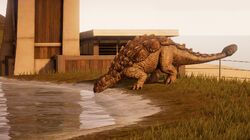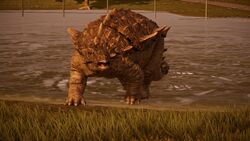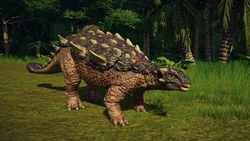| Ah, the Crichtonsaurus. Named after the author Michael Crichton. Famous for his stories about infectious viruses, sentient nanobots, and also a novel about ancient animals - which I quite enjoyed. This is a social dinosaur that does well in groups. |
Crichtonsaurus is a genus of ankylosaurid dinosaur in the Jurassic World Evolution series. Named after Jurassic Park author Michael Crichton, Crichtonsaurus originated from Late Cretaceous Asia.
In Evolution, Crichtonsaurus is featured in the Deluxe Dinosaur Pack, and can be unlocked in the Campaign Mode by progressing through the Science Division on Isla Matanceros, and becomes available through the Research Centre.
Characteristics
Named after the famous author Michael Crichton, Crichtonsaurus is a small species of herbivorous ankylosaurid dinosaur related to the larger Ankylosaurus, only much smaller – weighing around 450kg and measuring approximately seven meters in length. It is similar in appearance to its larger and more famous cousin, with large, thick osteoderms covering its back and a powerful club at the end of its tail that protects it from predators. However, the lack of unique traits in its holotype suggests that it might not be a distinct genus. The base genome of the Crichtonsaurus has a brown-grey colouration.
Gameplay
Evolution
Behaviour
Crichtonsaurus is one of the more social ankylosaurid dinosaurs, and can comfortably live in a social group of up to five other members of its kind, and in a mixed species exhibit of up to eight other dinosaurs of various species. Crichtonsaurus requires a relatively small exhibit, and is therefore quite easily contained. Like other armoured dinosaurs, Crictonsaurus will defend itself from medium and large carnivores, but can be housed peacefully with small predators.
With the addition of palaeobotany in the Claire's Sanctuary expansion pack, Crictonsaurus have a primary preference for Horsetails, a secondary preference for Paw Paw and Mosses, and will become harmed if they consume Tree Ferns, Conifers or Ginkgo.
Available genomes
| Fossil icon | Dig site | Quality | Number available |
|---|---|---|---|
| Yuliangze Formation | ★ ★★ ★★★ ★★★★ |
2 6 12 8 |
Skins
Paleontology
The first Crichtonsaurus remains were discovered by Chinese paleontologist Dong Zhiming in 1999, when he found parts of a jawbone in the Sunjiawan Formation, Liaoning Province. Further related specimens were subsequently discovered nearby, although there is some disagreement over the exact classification of this genus. So far only partial skeletons have been recovered. With that, the species is estimated to measure around three meters long and weigh half a ton, but due to the lack of proper skeletal remains, this remains unknown.
Although now regarded as a dubious genus, Crichtonsaurus was named to honour Michael Crichton, the author of Jurassic Park and its sequel, The Lost World. The fossils found so far are rather scant, consisting of a jaw and teeth, a skull and pieces of backbone and armour. There is little to tell from these remains and there has been much confusion due to two other species found in the same formation, the Sunjiawan Formation. All that can be said so far is that it is a primitive ankylosaurid. It is sometimes regarded as a synonym of the similar genus Crichtonpelta.
Paleoecology
Crichtonsaurus lived in China during the Late Cretaceous period, around 95 million years ago. At a height of just over two meters, it fed on low-lying vegetation in forests and surrounding grasslands. It tended to stay away from other species of dinosaur, preferring to live in small herds. Other than this, little else is known of the ecology for this region, but it was likely to have been subtropical.
Gallery
External links
- Crichtonsaurus on Wikipedia











